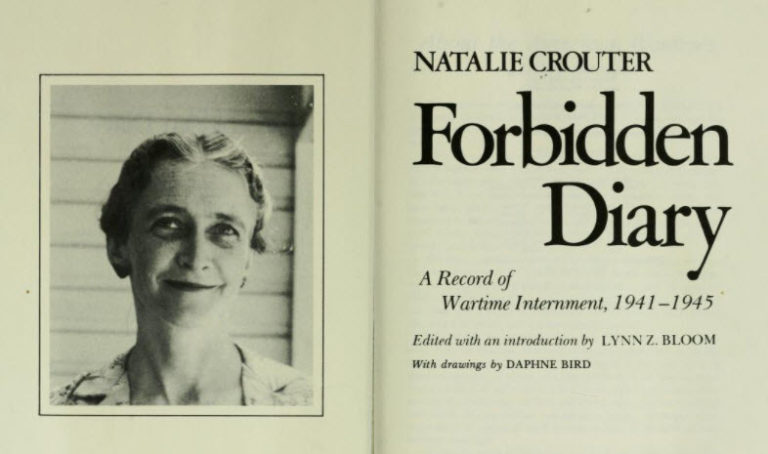About Forbidden Diary
Here’s the Story
Forbidden Diary has had five lives so far. From 1941 to 1945 Natalie Crouter risked her life keeping a diary while interned in Baguio, a Japanese civilian prison camp in the Philippines. On envelope flaps, bits of ledger paper, and margins torn from books Natalie wrote every day in a microscopic script about how she, her family, and 500 other civilian prisoners survived. She hid the contraband from guards by sewing it inside plastic raincoat scraps which she concealed under food supplies.
After liberation, U.S. Army Intelligence confiscated the diary for war crime evidence without so much as a receipt. And then they lost it. Natalie’s husband’s search went from Boston to the Philippines and to Australia, until the diary turned up a year and a half later in a giant Army warehouse in Kansas City, still stitched inside pieces of raincoats.
Back home in Cleveland, Ohio, Natalie slowly recovered from the effects of prison camp starvation and eventually turned to transcribing the recovered jumble of paper scraps into a 5000-page manuscript, an effort that took more than two years. With her mission of recording and preserving what happened completed, she never gave up trying to find a publisher.
While writing daily in her secret diary, Natalie came to realize that keeping an accurate, intimate, first-hand account of life in internment was her life’s mission.

As Baguio Camp’s self-appointed historian, she spent several years seeking a publisher, rebuffed by their focus on sensationalism: “Where are the rapes?” “Where are the murders?” There were none, in this account of community and family life in confinement. Finally, in 1968, she heard Dr. Lynn Z. Bloom give a lecture on her work-in-progress, Dr. Spock: Biography of a Conservative Radical (published in 1972).
“Natalie approached me about transforming her mammoth diary manuscript into a publishable book,” recalled Bloom, a specialist in auto/biography and creative nonfiction author who at 87 will publish her 25th book, Recipe (about the cultural and social aspects of recipes) in 2022. “She believed we were on the same wavelength and trusted me.”
Bloom distilled the typescript into 522 printed pages that emphasized the human story. Forbidden Diary published in 1980, received many accolades, from Book-of-the-Month Club, to selection 2001 as one of 200 distinguished North American Women’s Diaries and Letters Alexander Street Press (CD-ROM). Diarists and scholars consider Forbidden Diary an iconic work. Two movie scripts were written based on Forbidden Diary but unfortunately never produced.
Forty years passed.
While killing time on a 2020 trip to Norfolk, Virginia, I toured the MacArthur Memorial museum. A used copy of Forbidden Diary on display in the gift shop captivated me, and I bought it. I kept thinking about the book months after returning home. Its publisher had long gone out of business, so on a whim I chanced an internet search, quickly found the book’s new publishing house, and sent a query. The next day an email arrived with Natalie’s son’s contact information.
After being hidden from guards, lost by the U.S. Amy, laboriously typed into a manuscript, and published as Forbidden Diary, Natalie’s story is now being told in a different way to a new audience over the internet. Natalie would be surprised, and perhaps comforted, that her story is in its fifth life as an audio drama similar to the radio shows she, her family, and neighbors listened to before their lives were turned upside.
Chris Robinson
Writer and Producer
Forbidden Diary Audio-Drama